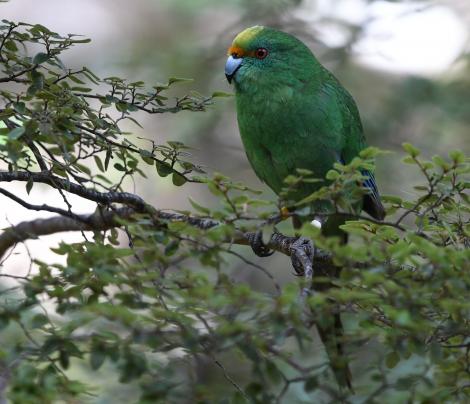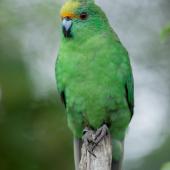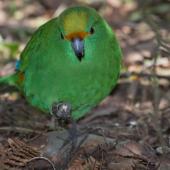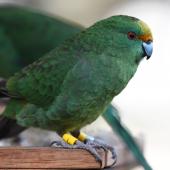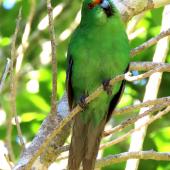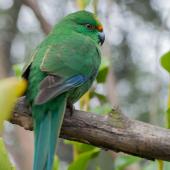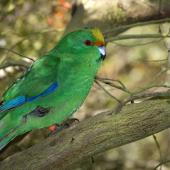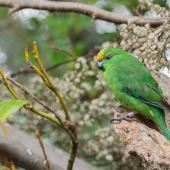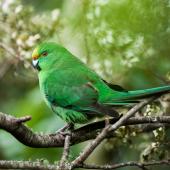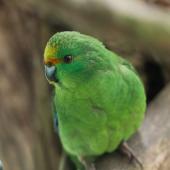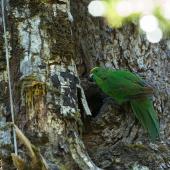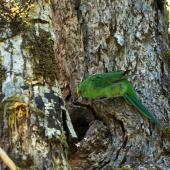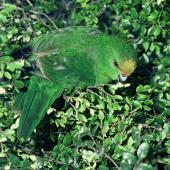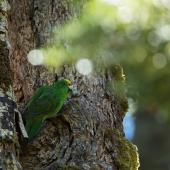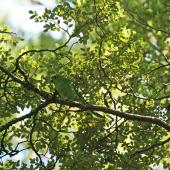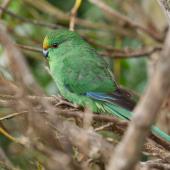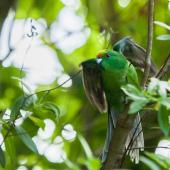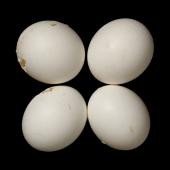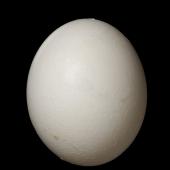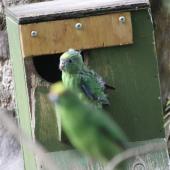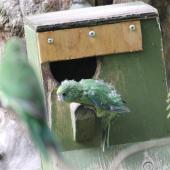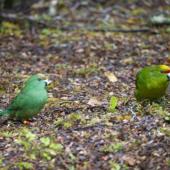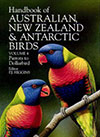Orange-fronted parakeet | Kākāriki karaka
Cyanoramphus malherbi Souancé, 1857
Order: Psittaciformes
Family: Psittaculidae
New Zealand status: Endemic
Conservation status: Nationally Critical
Other names: Malherbe's parakeet, kākāriki, kakariki, kakariki karaka, orangefronted parakeet, orange fronted parakeet
Geographical variation: Nil (previously considered to be a colour morph of yellow-crowned parakeet)
This budgerigar-sized parakeet is usually quiet and difficult to observe. A loud brief chatter or quieter contact call may give away its presence, but locating the bird can be extremely difficult. Orange-fronted parakeets are often confused with yellow-crowned parakeets. Formerly occurring throughout New Zealand, orange-fronted parakeets are now confined to four South Island beech forest valleys. Captive-reared birds have also been released on four offshore islands.
Identification
Orange-fronted parakeets are small, green, long-tailed parakeets with a bluish tint to their plumage, and azure blue on their outer primaries and primary coverts. The crown is lemon yellow, and the frontal band above the eyes is orange, as are patches on either side of the rump. Colours tend to be brighter in males. Juveniles are duller, especially the frontal band and crown patch, which may be absent.
Voice: most often a loud chatter call, of varying intensity and length. When a pair is together, softer contact calls are commonly heard, sometimes in addition to squeaks and churring. Calls made during courtship feeding and mating are quite distinctive, and comprised of single notes.
Similar species: can be easily confused with the yellow-crowned parakeet, especially when juveniles are present. Yellow-crowned parakeets have a crimson frontal band and rump patches. A clear view of the frontal band or rump patch is required to accurately separate the two species. Identifying fledgling parakeets is particularly difficult, as their heads have very little coloration. The calls of the two species are very similar.
Distribution and habitat
Orange-fronted parakeets are restricted to four beech (Fuscospora spp.) forest valleys in the South Island: the Hawdon, Andrews and Poulter valleys in Arthur’s Pass National Park and the south branch of the Hurunui valley in Lake Sumner Forest Park. Their distribution within these valleys is very patchy, and the species is absent from most areas. They have been translocated to four islands: Maud Island and Blumine Island in the Marlborough Sounds, Chalky Island in Fiordland, and Tuhua (Mayor) Island in the Bay of Plenty, plus the Brook Waimārama Sanctuary near Nelson. The populations on Chalky, Maud and Tuhua Islands persisted for a decade or so, but the birds are probably no longer present at these sites.
Orange-fronted parakeets occur almost exclusively in beech forests, although they are occasionally recorded in subalpine tussock and open, matagouri shrubland. They typically feed at the tops of tall trees, but can also be found amongst low vegetation, or on the ground. Dense, regenerating bush is also popular, especially with juveniles. All parts of the forest are used, including streams for drinking and bathing. If a beech mast has occurred, orange-fronted parakeets will usually be found consuming seeds high in the canopy.
Population
This species is exceptionally difficult to count, largely because of its rarity, and cryptic and quiet nature, but also due to its similarity to the sympatric yellow-crowned parakeet. Numbers in the Hawdon, Andrews, and Poulter valleys are extremely low. The south branch of the Hurunui currently has the largest population on the mainland, being comprised almost entirely of birds that have been released from captivity. Even so, there are probably fewer than 100 mature parakeets on the mainland, and perhaps 200-300 on islands following translocations.
Threats and conservation
The main threat to orange-fronted parakeets is from introduced predators, especially ship rats and stoats, and particularly during irruption years following mast seeding events. Parakeet eggs and nestlings are also vulnerable to predation by possums, and fledglings are an easy target for cats. Habitat modification is also a threat, predominantly by deer and possums. The recent discovery of Psittacine Beak and Feather Disease (PBFD) as far south as the Eglinton Valley (Fiordland), is also of concern. Competition with introduced species could be an issue as well, and common starlings are known to have taken over at least two hollows used by orange-fronted parakeets.
The three main actions taken to prevent the extinction of orange-fronted parakeet are: 1) control of rats, stoats, and possums in the valleys where orange-fronted parakeets occur; 2) protection of nests by fitting metal collars around the trunks of trees at nest sites; and, 3) rearing captive individuals at Isaac Conservation and Wildlife Trust for release on predator-free islands and intensively managed sites.
Research is underway to get a better understanding of the species’ ecology and breeding biology in the wild, and trials are being undertaken to determine the effectiveness of supplementary feeding. Testing of individual birds for PBFD is ongoing.
The conservation status of this species was returned to Nationally Critical in 2016, following a decline on the mainland after a beech mast in 2014/15, and a decrease in some of the island subpopulations.
Breeding
Orange-fronted parakeets can breed in all months, but their main nesting period is between December and April, and incubation peaks in January. Mean clutch size is approximately 7, but a wide range has been recorded (from 1 to 10). Egg-laying is asynchronous, with an interval of 2 days between eggs. Incubation takes 21-26 days, and the nestling period lasts 35-45 days. Females appear to choose the nest site and undertake all preparation, incubation and brooding. The male provides most of the food, especially during incubation. However, females regularly leave the nest to feed briefly with the male. It is suspected that only the female feeds the nestlings for the first 10-14 days, as with other Cyanoramphus species. After this period, both adults feed the nestlings.
Multiple clutches are not uncommon. If the first nesting attempt is unsuccessful, then the pair is likely to nest again once a suitable hollow is found. Some pairs may breed 3 or 4 times in succession when food is plentiful, such as during a beech seeding event. The female may lay another clutch when the first nestlings are approximately 2 weeks old. This leaves the male as the sole provider for both the nestlings and the incubating female.
Nests are usually accessed through knot holes, most often in large branches or in the trunk of a tree. They predominantly nest in red beech (69% of monitored nests on the mainland, n=138) and standing dead trees (20%), but other beech species are also used. Nest bowls can be level with the entrance hollow, or over a metre deep. Recorded nest height varies between 2.5 and 26 metres.
Behaviour and ecology
Orange-fronted parakeets were formerly (1800s) widespread across the South Island and several records exist for the North Island, Hen Island and Little Barrier Island during this period. Along with yellow-crowned and red-crowned parakeets, they were recorded in large numbers across the Canterbury Plains during the late 1800s. These irruptions were probably the result of a prolonged breeding season driven by heavy beech seeding. The birds were shot in vast numbers due to their feeding on domestic fruit orchards.
Extensive habitat modification to both alpine and lowland areas has impeded the species’ ability to search widely for food when their numbers are very high. As a result, their present habitat may be insufficient to allow numbers to return to former levels.
Food
Orange-fronted parakeets consume seeds, flowers, buds and invertebrates (e.g. scale insects and caterpillars). In a mast year, seeds become the dominant item in the diet, and appear to be the principal food for nestlings. Invertebrates appear to play a larger part in the diet of this parakeet species than for yellow-crowned parakeets. This may explain why they are often observed with insectivorous birds, such as yellowheads/mohua.
Weblinks
References
Elliott, G.P.; Dilks, P.J.; O’Donnell, C.F.J. 1996. The ecology of yellow-crowned parakeets (Cyanoramphus auriceps) in Nothofagus forest in Fiordland, New Zealand. New Zealand Journal of Zoology 23: 249-265.
Kearvell, J.C. 2002. Nest sites of sympatric orange-fronted (Cyanoramphus malherbi) and yellow-crowned parakeets (C. auriceps). Notornis 49: 261-263.
Kearvell, J.C. 2013. Interspecific competition for nest sites between common starlings (Sturnus vulgaris) and orange-fronted parakeets (Cyanoramphus malherbi) in the Poulter Valley. Notornis 60: 188-190.
Kearvell, J.C. 2016. Distribution of sympatric orange-fronted (Cyanoramphus malherbi) and yellow-crowned parakeets (C. auriceps) in the South Branch Hurunui, New Zealand, prior to a catastrophic population crash. Notornis 63: 167-172.
Kearvell, J.C.; Briskie, J.V. 2003. Similarity of chatter calls between orange-fronted parakeet Cyanoramphus malherbi and yellow-crowned parakeet C. auriceps. Ibis 145: 333-336.
Kearvell, J.C.; Connor, C.; Farley, M. 2014. Field identification of the orange-fronted parakeet (Cyanoramphus malherbi): pitfalls for the unwary. Notornis 61: 200-204.
Kearvell, J.C.; Farley, M. 2016. Adult sex ratios in wild orange-fronted parakeet (Cyanoramphus malherbi): are there conservation implications? Notornis 63: 26-31.
Kearvell, J.C.; Steeves, T.E. 2015. Evidence for strong assortative mating in sympatric populations of orange-fronted (Cyanoramphus malherbi) and yellow-crowned (C. auriceps) kākāriki. Notornis 62: 71-75.
Kearvell, J.C.; van Hal, J. 2016. Nest site selection by sympatric orange-fronted (Cyanoramphus malherbi) and yellow-crowned parakeets (C. auriceps) in Nothofagus spp. forest: interspecific competition between two closely related species? Notornis 63: 9-17.
Kearvell, J.C.; Young, J.R.; Grant, A.D. 2002. Comparative ecology of sympatric orange-fronted parakeets (Cyanoramphus malherbi) and yellow-crowned parakeets (C. auriceps), South Island, New Zealand. New Zealand Journal of Ecology 26: 139-148.
Ortiz-Catedral, L.; Kearvell, J.C.; Hauber, M.E.; Brunton, D.H. 2009. Breeding biology of the critically endangered Malherbe’s parakeet on Maud Island, New Zealand, following the release of captive-bred individuals. Australian Journal of Zoology 57: 433-439.
Rawlence, N.J.; Kennedy, M.; Scofield, R.P.; Tennyson, A.J.D.; Boussѐs, P.; Chambers, G.K. 2015. Taxonomic status of Cyanoramphus parakeets on the Auckland Islands and implications for the validity of the orange-fronted parakeet as a discrete species. Journal of the Royal Society of New Zealand 45: 197-211.
Robertson, H.A; Baird, K.; Elliott, G.P.; Hitchmough, R.A.; McArthur, N.J.; Makan, T.; Miskelly, C.M.; O’Donnell, C.F.J.; Sagar, P.M.; Scofield, R.P.; Taylor, G.A.; Michel, P. 2021. Conservation status of birds in Aotearoa New Zealand birds, 2021. New Zealand Threat Classification Series 36. Wellington, Department of Conservation. 43p.
Young, J.; Kearvell, J.C. 2001. Distinguishing between sexes and species: bill size in orange-fronted and yellow-crowned parakeets (Cyanoramphus auriceps). Emu 101: 137-142.
Recommended citation
Kearvell, J.C.; Legault, A.J. 2017 [updated 2023]. Orange-fronted parakeet | Kākāriki karaka. In Miskelly, C.M. (ed.) New Zealand Birds Online. www.nzbirdsonline.org.nz
Orange-fronted parakeet | Kākāriki karaka
- Social structure
- monogamous
- Breeding season
-
- Jul
- Aug
- Sep
- Oct
- Nov
- Dec
- Jan
- Feb
- Mar
- Apr
- May
- Jun
- Nest type
- tree hole
- Nest description
- Tree hole with a cavity lined with dead wood. When translocated to islands the species may nest in ground burrows or in in the stems of dead tree fern.
- Nest height (mean)
- 10.3 m
- Nest height (min)
- 2.5 m
- Nest height (max)
- 26 m
- Maximum number of successful broods
- 4
- Clutch size (mean)
- 7
- Clutch size (min)
- 1
- Clutch size (max)
- 10
- Mean egg dimensions (length)
- 22.5 mm
- Mean egg dimensions (width)
- 18.8 mm
- Egg colour
- White
- Egg laying dates
-
- Jul
- Aug
- Sep
- Oct
- Nov
- Dec
- Jan
- Feb
- Mar
- Apr
- May
- Jun
- Interval between eggs in a clutch
- 1.9 to 2 days
- Incubation behaviour
- female only
- Incubation length (mean)
- 24 days
- Incubation length (min)
- 21 days
- Incubation length (max)
- 26 days
- Nestling type
- altricial
- Nestling period (mean)
- 40 days
- Nestling period (min)
- 35 days
- Nestling period (max)
- 45 days
- Age at fledging (min)
- 56 days
- Age at fledging (max)
- 71 days
- Age at independence (mean)
- 2-4 weeks in captivity
- Age at first breeding (typical)
- Released birds will breed within 3-4 months of fledging, if the conditions are suitable. First breeding recorded on Chalky Island 2 months, Maud Island 7 months. Wild birds have also been observed breeding within several months of fledging.
- Maximum longevity
- Unknown in the wild; up to 10 years in captivity
- Maximum dispersal
- Unknown




